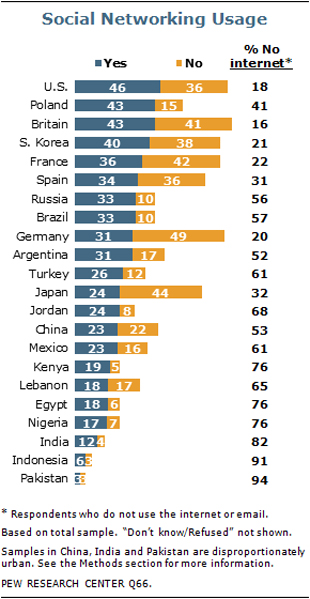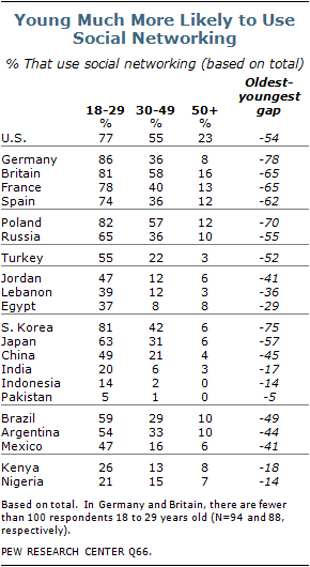Pew Research调查:年轻用户成主力 社交网站受欢迎
据Pew Research Center今年4月至5月的调查发现,社交网站虽然还只是一项新技术,但在不同经济发展水平的地区都有不少用户,在年轻群体中尤其受到青睐。
在针对22个国家的调查表明,美国这个社交网站发源地的用户最经常登陆Facebook和MySpace这类网站,活跃用户达到46%,还有36%的互联网用户从来不使用社交网站,仅18%受访者表示从来不上网。
社交网站用户比例排在美国之后的是波兰(43%),英国(43%)和韩国(40%),在法国有36%的受访者称自己经常登陆社交网站,西班牙是34%,俄罗斯是33%,巴西也是33%。
德国和日本比较特殊,这两个国家的互联网普及率都很高,但社交网站用户比例却相对较低。德国虽然有49%的互联网用户,但社交网站用户仅占31%;日本有44%的受访者已有网络体验,但社交网站用户也仅占24%。
据游戏邦了解,在一些经济较不发达的国家和地区中,社交网站用户虽然也不多,但这主要归咎于这些地区互联网覆盖率普遍较低,而非用户本身对社交网站不感兴趣。
比如说俄罗斯和巴西,大部分受访者都没上过网,而已有网络体验的用户却很喜欢浏览社交网站。在这两国受访者中,均有33%用户称经常使用社交网站,仅有10%的互联网用户表示从来不访问社交网站。
在非洲的肯尼亚、尼日利亚两国中也出现了这种趋势,有19%的肯尼亚互联网用户经常访问社交网站,非社交网站用户仅占5%;尼日利亚有17%的社交网站用户,仅7%互联网用户没有上过社交网站。
在调查的22个国家中,社交网站用户比例最低的是印度尼西亚(6%)和巴基斯坦(3%)。但需要指出的是,这两个国家均有90%以上的群体从来不上网。
在另一项针对12个国家的调查还发现,社交网站对30岁以下的年轻群体最有吸引力。只有英国、波兰和美国最为特殊,这三国的社交网站主力军是30至49岁的用户群体。在这12个调查国家中,50岁以上的社交网站用户比例均少于四分之一。
在其中10个国家,18至29岁社交网站用户与50岁以上用户比例差距甚大,相差至少50%;德国社交网站用户的年龄差异更为明显,86%用户的年龄不到30岁,30至49岁用户比例达36%,而50岁及其以上者仅占8%。
虽然年轻人的确更常上网,但这种结果与互联网使用频率并无直接联系,因为在互联网用户中,最积极访问社交网站的群体也仍然是年轻人。
调查还表明,社交网站的男女用户比例相对均衡,并没有出现明显的差距。
但也有一些例外情况,比如说土耳其,该国男性社交网站用户约34%,而女性用户却仅占19%;在日本也同样如此,男性用户占30%,女性用户只有19%。
美国是唯一一个女性用户超过男性的地区,前者占52%,后者仅41%。但这种情况与两者上网频率无关,因为美国有18%的女性、17%的男性称自己从来不上网,这两者的比例相当对称。(本文为游戏邦/gamerboom.com编译,转载请注明来源:游戏邦)
Global Publics Embrace Social Networking
Although still a relatively young technology, social networking is already a global phenomenon. In regions around the world – and in countries with varying levels of economic development –people who use the internet are using it for social networking. And this is particularly true of young people.
While social networking has spread globally, it is particularly widespread in the country where it began. Among the 22 publics surveyed, Americans most often say they use websites like Facebook and MySpace: 46% use such sites; 36% use the internet, but do not access these sites; and 18% say they never go online.
The survey finds three countries close behind the United States in social network usage: in Poland (43%), Britain (43%) and South Korea (40%), at least four-in-ten adults say they use such sites. And at least a third engage in social networking in France (36%), Spain (34%), Russia (33%) and Brazil (33%).1
Germans and the Japanese stand out among highly connected publics for their comparatively low levels of participation in social networking. While 31% of Germans use these types of sites, 49% go online at least occasionally but choose not to use them. In Japan, 24% are engaged in social networking, while 44% have internet access but are not engaged.
The survey by the Pew Research Center’s Global Attitudes Project, conducted April 7 to May 8, also finds that, while involvement in social networking is relatively low in many less economically developed nations, this is largely due to the fact that many in those countries do not go online at all, rather than disinterest in social networking in particular. When people use the internet in middle and low income countries, they tend to participate in social networking.
For example, in both Russia and Brazil, most respondents do not go online; among those who do use the internet, however, social networking is very popular. In both nations, 33% say they use social networking sites, while only 10% have internet access but are not involved in social networking.
The same general pattern holds true in the two African nations surveyed – in Kenya and Nigeria, when people have the opportunity to go online, they tend to use social networking sites. Roughly one-in-five Kenyans (19%) participate in social networking, while just 5% use the internet but do not participate. Similarly, 17% of Nigerians go to these sites, while only 7% go online but do not access such sites.
Among the 22 countries polled, social networking is least prevalent in Indonesia (6%) and Pakistan (3%). In both nations, more than 90% of the population does not use the internet.
Demographic Differences in Social Networking
In every nation surveyed, there is a notable age gap on this issue. Social networking is especially popular among people younger than age 30 – in 12 of the countries polled, a majority of this age group uses these types of sites. There are only three countries – Britain, Poland and the U.S. – in which most 30 to 49 year-olds are involved in social networking. And there is no country in which even one-quarter of those age 50 and older are involved.
In 10 countries, a gap of at least 50 percentage points separates the percentage of 18 to 29 year-olds who use social networking sites and the percentage of those age 50 and older who do so.
The age gap is perhaps most striking in Germany, where 86% of people under age 30 take part in social networking, compared with 36% of 30-49 year-olds and just 8% of those 50 and older.
While it is true that the young are more likely to go online, these age gaps are not driven solely by internet usage. Even among internet users, young people are more likely to participate in social networking.
There are relatively few gender gaps across the countries surveyed. For the most part, men and women tend to engage in social networking at roughly the same rates.
However, there are a few exceptions, including Turkey, where about one-third of men (34%) use social networking, compared with only 19% of women. Similarly, in Japan 30% of men report that they are involved in social networking, while just 19% of women say the same.
The U.S. is the only country in which women are significantly more likely than men to use social networking. While 52% of American women engage in social networking, just 41% of men do so.
This gap is not driven by a difference in access – similar percentages of women (18%) and men (17%) say they do not access the internet.(source:Pew Research Center)









































 闽公网安备35020302001549号
闽公网安备35020302001549号